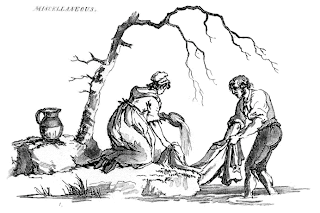Various chemicals may be used increase the solvent power of water, such as the compounds in soaprootor yucca-root used by Native American tribes. Soap, a compound made from lye (from wood-ash) andfat, is an ancient and very common laundry aid. However, modern washing machines typically use powdered or liquid laundry detergent in place of soap.
When no streams were available, laundry was done in water-tight vats or vessels. Sometimes large metal cauldrons were filled with fresh water and heated over a fire; boiling water was even more effective than cold in removing dirt. The washboard, a corrugated slab of a hard material such as metal, replaced rocks as a surface for loosening soil.
Once clean, the clothes were wrung out — twisted to remove most of the water. Then they were hung up on poles or clotheslines to dry, or sometimes just spread out on clean grass.


No comments:
Post a Comment